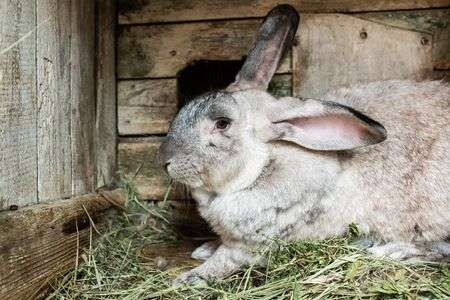

Rabbits have a high reproductive rate compared to other livestock. They become sexually mature within a few months of birth and have relatively short pregnancies. They produce large litters and are unique in that they can be rebred immediately after kindling (giving birth). With an intensive breeding program, a doe can be expected to have 60 weaned young a year. Such intensive breeding is not recommended, however, for the beginner and is seldom used in commercial production.
Often a Doe will refuse to mate with a buck. When this happens, try her with another buck or return her to the cage and try her again in 2 to 4 days. Don’t leave a Doe unattended in a buck’s cage. An aggressive buck and a non-receptive Doe left alone together could hurt each other. In some cases, it may be necessary to restrain a Doe for mating. Do this by holding the doe by the shoulders with one hand. Place your other hand under her body between the hind legs (this raises her hindquarters to the normal height for service) and move her tail up or to one side. Most bucks will readily adapt to such assistance by the rabbit raiser.
Rabbits often show a natural decline in productivity during the late summer, fall and early winter. Both reception and conception rate may decrease during this time. Selecting breeders from stock that produces well all year will help ensure good production during this period.
Exposure to temperatures over 85 °F for 5 consecutive days can cause temporary sterility in bucks. Old bucks tend to be more susceptible to heat than younger bucks and can remain sterile for 60 to 90 days. To help reduce male sterility due to hot weather, keep breeding bucks in the coolest part of the rabbitry, and mate them frequently.
Pseudopregnancy (false pregnancy) is a condition in which a Doe seems to be pregnant but is not. This can result from a sterile mating or from physical stimulation, such as being mounted by another rabbit, which causes a physiological response in the Doe, resembling pregnancy. During pseudopregnancy, which lasts about 17 days, the Doe will not breed. She may also construct a nest, even though she may not be expecting. Although the condition is normal and not harmful to the Doe, it will delay breeding.
Another common reproductive problem occurs when does fail to conceive after mating. This is usually because they are overweight or have been out of production for a long period. Excessively overweight bucks can also pose a problem because they tend to be lazy and lack libido (sexual desire). Poor physical condition, old age, disease, injury and inadequate nutrition are other factors that can cause reproductive problems. As a rabbit raiser, you should strive to keep your breeding animals in a trim, active and healthy condition for the best reproductive performance.
 Contact Jaguza Support
Contact Jaguza Support